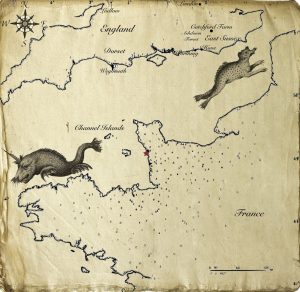
“It’s snowing still,” said Eeyore gloomily.
“So it is.”
“And freezing.”
“Is it?”
“Yes,” said Eeyore. “However,” he said, brightening up a little, “we haven’t had an earthquake lately.”
A.A. Milne, The House at Pooh Corner (1928)
The above is a quote from one of two classic Winnie-the-Pooh books by A. A. Milne. Upon reading this, you might experience one or more of the following sensations:
- You are repulsed by the fact that this seismology blog entry starts with something as juvenile as Winnie-the-Pooh (In this case: bear with me, it will make sense)
- You think nothing too much of it and continue reading
- You are charmed by the ‘Always look on the bright side’-message from the gloomy Eeyore
- You are utterly confused as to where the hell this is going
Personally, I experienced the ‘charmed’ option. However, it was quickly followed by the following thought process:
So cool that there is a mention of an earthquake in a classic book! … Milne’s Winnie-the-Pooh books take place in the fictional Hundred Acre Wood … This is generally accepted to be a fictionalisation of the Five Hundred Acre Wood in Ashdown Forest in East Sussex in the South of England … Wait … “we haven’t had an earthquake lately” … Since when are there earthquakes in Sussex such that they can be felt by humans (if not stuffed animals) multiple times during their lifetime?!
So, that, my dear readers, is what brought me to my latest google-escapade: finding out more about historic earthquakes in East Sussex. Wouldn’t you love to be me with all these exciting hobbies? I thought so.
Let’s first define what we are exactly trying to figure out: Were there any earthquakes (felt) in Sussex in the time frame 1925-1928? We pick this time frame as Milne first moved to East Sussex in 1925 to a country home, Cotchford Farm in Hartfield. Hence, any earthquakes felt there by Milne, his son (Christopher Robin, I kid you not) or his son’s stuffed animals (i.e., Eeyore) must be felt after 1925. In 1928 the book was published, so earthquakes must be felt before then.
Within this time frame, there are only 4 earthquakes listed in the UK Historical Earthquake Database. 2 of which are in Scotland with a local magnitude of ~4 and hence cannot be felt in East Sussex. Another earthquake is in the North Sea between Scotland and Norway, so again, no chance of Winnie-the-Pooh feeling this one. The 1926 earthquake in Ludlow (West Midlands, epicenter ~235 km from Cotchford Farm) with local magnitude 4.8 is already quite a bit closer to East Sussex. Several people from Somerset to Lincoln reportedly felt an earthquake intensity of 5 on the Medvedev-Sponheuer-Karnik scale (= felt indoors by most, outdoors by few, Medvedev et al., 1964). However, there is no mention of people in East Sussex feeling this particular earthquake.
And so, we have exhausted our first line of inquiry.
But worry not, dear readers! We can also look at the list of Significant British Earthquakes that the British Geological Survey provides us with!
This list gives us 4 significant earthquakes that were felt in the UK between 1925 and 1928. One of them is the aforementioned 1926 Ludlow earthquake, and another one happened in 1925 in Brittany, which was felt as far east as the Weymouth area in Dorset (which is much farther west than East Sussex). That leaves us with 2 other interesting earthquakes: the Channel Islands earthquakes that occurred in 1926 (ML5.5) and 1927 (ML5.4) which both had the same epicenter ~246 km from Cotchford Farm. The 1926 earthquake was reportedly felt as far east as Hove (~35 km from Cotchford Farm), and the 1927 earthquake was felt at low intensities as far east as Worthing (~45 km from Cotchford Farm) and even in London (lending credibility that it could also be felt at Cotchford Farm).
-
But why stick to possibilities, maybes, and mights, when we can actually do the math (or rather calculation) to figure out if Eeyore and his friends felt any of these earthquakes? Musson (2005) proposed an equation to calculate the intensity attenuation in the United Kingdom on the European Macroseismic Scale (Grünthal, 1998) for earthquakes recorded in the local magnitude. And today is our lucky day, because the earthquakes listed in the catalogs of the British Geological Survey are indeed listed in local magnitude*. Hooray!
Using the equation:
I = 3.31 + 1.28ML – 1.22lnR
where R is the hypocentral distance, we calculate the intensities at Cotchford Farm for the Ludlow earthquake and the two Channel earthquakes. We find that the Ludlow earthquake had an intensity of 2.8, the 1926 Channel Islands earthquake had an intensity of 3.6 and the 1927 earthquake had an intensity of 3.5. On the European Macroseismic Scale (Grünthal, 1998), intensities of 2 are considered ‘Scarcely felt – only at isolated instances of individuals at rest and in a specially receptive position indoors’, an intensity of 3 is ‘Weak – felt indoors by few; people at rest feel a swaying or light trembling’, and an intensity of 4 is ‘Largely observed – felt indoors by many, felt outdoors by very few’. As stuffed animals are usually inside and at rest (who really knows?) it is likely that Eeyore and his friends felt these earthquakes! This means that Eeyore is referring to these two Channel Islands earthquakes and perhaps also the Ludlow earthquake in The House at Pooh Corner.
So now, whenever you are reading Winnie-the-Pooh (either to yourself or to children) keep in mind that Winnie-the-Pooh, Eeyore, Piglet, Owl, Rabbit, Kanga, Roo, Tigger and of course Christopher Robin himself, might have felt these 1926 Ludlow and 1926, 1927 Channel Islands earthquakes while playing in the Hundred Acre Wood; making Eeyore justifiably relieved in 1928 that they haven’t had an earthquake lately.**
* Don’t worry if you would ever like to do something similar as I do here with your earthquakes and they are not in local magnitude! Musson (2005) provides an equation to convert local magnitude and moment magnitude.
**Of course, you could argue about the long-term memory capacity of stuffed animals, but let’s not get into that now, shall we?
References:
Ambraseys, N. “Intensity‐attenuation and magnitude‐intensity relationships for northwest European earthquakes.” Earthquake engineering & structural dynamics 13.6 (1985): 733-778.
Grünthal, G. (ed.), 1998, “European Macroseismic Scale 1998”, Cahiers du Centre Europèen de Gèodynamique et de Seismologie,15, Conseil de l’Europe, Luxembourg.
Medvedev, Sergeĭ V., Wilhelm Sponheuer, and V. Karnik. “Seismic intensity scale version MSK 1964.” United nation educational, scientific and cultural organization, Paris (1965): 7.
Musson, R. M. W. “Intensity attenuation in the UK.” Journal of Seismology 9.1 (2005): 73-86.

